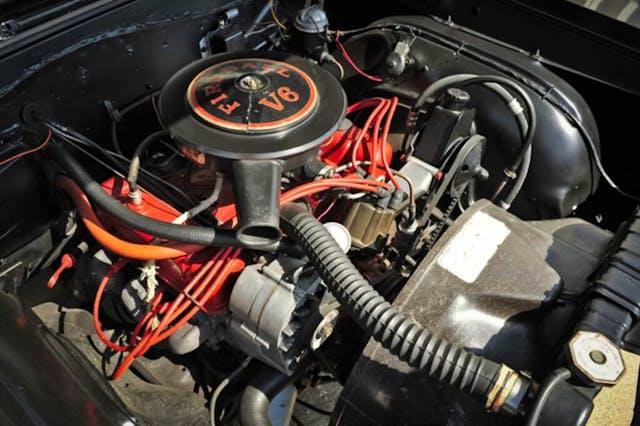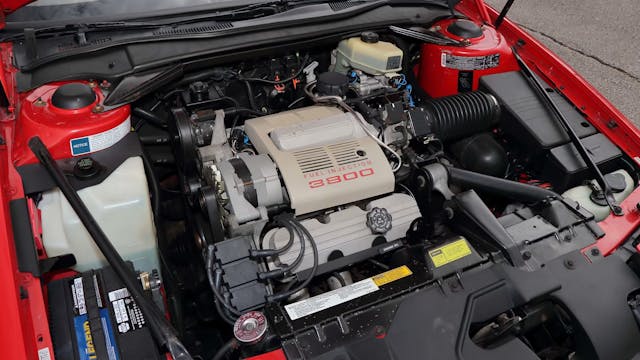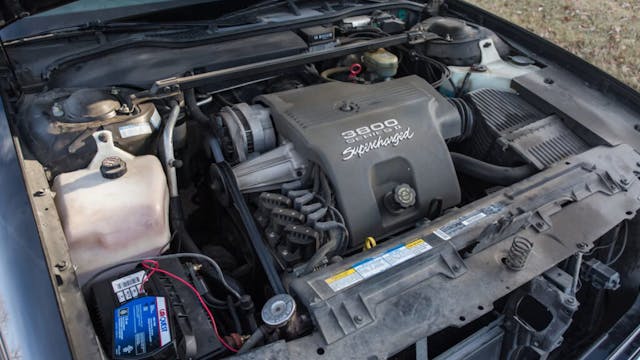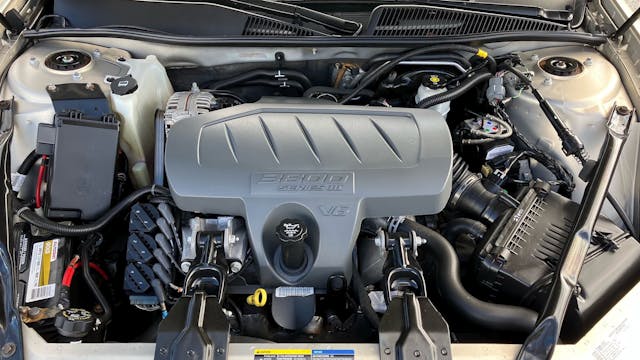GM’s 3800 V-6 was long-lived and underappreciated
The Chevy small-block V-8 is perhaps the most famous engine ever produced by General Motors. It is a simple, stalwart design whose popularity and status only cemented as it became the powerplant of choice among hot-rodders. For more than 50 years, the small-block has been the backbone of affordable speed. However, just as significant in GM history is an engine that toiled (albeit less prominently) for nearly as long: the 3800 V-6.
Between its 1975 debut and its 2008 sunset, this 3.8-liter V-6 was installed under the hood of more than 25 million vehicles. Originally designed by Buick, it was mostly assigned to workhorse duty for Oldsmobile, Pontiac, and Buick, motivating fleets of sensible sedans and coupes. While the 3800 did enjoy a few flashes of auto enthusiast attention, it never got the same widespread adulation as the small-block or even the big-block, and many assign it second-tier status among engines in GM’s historic portfolio.
Here’s the story of how a derivative, near-castoff engine design came to be critical in fueling the fortunes of America’s largest car company.
Aluminum bad, iron good (but rough)
The 3800’s origins date back to the early 1960s, when Buick debuted the first V-6 passenger car engine ever to be manufactured in the United States. A byproduct of the company’s quest to produce its own unique, aluminum-block V-8 (marketed as the Fireball), the cast-iron V-6 Fireball was far easier and significantly cheaper to build. This being a mass-market powerplant, it also helped that the V-6 version did not suffer the high rate of defects associated with the V-8’s aluminum construction.
Unfortunately, despite the benefits of its relatively light weight, the Fireball V-6 retained several design elements from the V-8 that, initially, proved sub-par in translation. As a cost-cutting measure, GM effectively sliced a pair of cylinders from the end of the original engine while retaining the 90-degree bank angle. Though the V-8 enjoyed the balance of an even firing interval, the V-6 version had an odd firing interval that gave these early 3.2-liters a rough, rumbly idle.

Even with softer, flexible motor mounts to absorb vibrations, it won few fans. The V-6 floated through the small and “intermediate” Buick and Oldsmobile line-ups between 1962 and 1967, and even a displacement boost couldn’t convince GM execs to stay the course.
Instead of reengineering the V-6 at great cost, perhaps with a balance shaft, Buick made a shrewder move: it offloaded the Fireball V-6 tooling to Kaiser-Jeep, which had no qualms about stuffing a less-than-smooth motivator into its Jeeps and other rustic SUVs. Fortunately, a third-act mea culpa forced by the OPEC energy crisis saw GM buy back the rights to its own engine design from a cash-starved AMC in 1974, after realizing its fuel-efficient cupboards had run largely bare.
It’s here that the 3800 series found its true beginning.
Will the real V-6 please stand up?

Always cost-conscious, GM had first tried to sweet-talk AMC into handling manufacturing the overhead-valve V-6 engine. After being rebuffed (or repulsed by a desperate American Motors quoting an exceptionally high price tag for production, depending on which story you believe), GM changed tack. It took a quick and easy route to push the V-6 to the market for 1975, punching displacement out to its final 3.8-liter form—in its own factory—but leaving everything else about the motor unchanged.
The 3.8-liter V-6 saturated GM showrooms almost immediately, powering models as diverse as the Chevrolet El Camino, the Pontiac LeMans, and the Buick Skyhawk, with stops in the Oldsmobile Cutlass and the Pontiac Firebird along the way. With close to 20 different models laying claim to the V-6, economies of scale were such that Buick’s once-cast-off engine finally warranted the refinement and development it had previously been denied a decade before. This primarily took the form of a split-pin crankshaft that revised the engine with an even-firing pattern, effectively erasing the previous, unpleasant vibrations.
This one simple decision, arriving in 1977, helped cement the engine as the bedrock of the General Motors passenger car. However, despite its status as an affordable powerplant (true for both manufacturers and buyers), the V-6 was about to pull a power move seldom seen in the automotive world: The humble 3.8 made a play for enthusiasts’ hearts with a red-hot high-performance edition.
Soaring fuel prices and crushing emissions regulations, you may recall, had sidelined large-displacement V-8 engines for much of the 1970s. That caused automakers far and wide to search for alternatives to big cubic inches. Buick had been toying with turbocharging for several years prior to the 1978 launch of its T-Type family, and boosted versions of the V-6 ultimately covered almost every two-door car built by the brand. The setup even branched out into motivating the Pontiac Trans Am Turbo and Chevrolet Monte Carlo Turbo. Forced induction proved an unexpected edge for GM as it moved into the ’80s, culminating in the era-defining Regal Grand National and GNX models. These legendary eight-cylinder-slayers owe their success to the might of GM’s turbo 3.8-liter V-6 engines.
Front-wheel drive future

While the rear-drive Grand National and its longitudinal engine may have garnered the most headlines, it was the transverse version of the 3.8-liter V-6 that had the broadest influence in the industry. General Motors was knee-deep in its transition to front-wheel drive platforms by the middle of the 1980s, and it massaged and modified the 3.8 to meet this new challenge. In the space of a few short years, the engine abandoned carburetors for electronic fuel injection, lost its traditional ignition distributor, and gained a balance shaft—moves that thoroughly modernized the V-6 to match the expectations generated by the rising tide of competing Japanese imports.
By 1988, the 3800 moniker became official. It was applied to a fresh crop of 3.8-liter engines that embodied the sweeping updates making so-equipped GM cars competitive with Ford, Toyota, and Honda. Dubbed the “Series I,” the engine was initially assigned to the mid-size and full-size sedans and coupes first to heed GM’s front-wheel drive call. It wasn’t long, though, before the transverse 3800 had spread into nearly every corner of the Buick, Chevrolet, Pontiac, and Oldsmobile empire.
Once again the bread and butter of General Motors’ engine strategy, the 3800 was once again courting forced induction at the start of the 1990s. This time it was a supercharger (rather than a turbo) stuffing additional atmospheres into the combustion chamber, and a blower first found its way into big-boned Buicks via the Park Avenue and its Oldsmobile and Pontiac equivalents.
Stay of execution

One more major metamorphosis awaited the 3800, this one nearly 35 years after its initial Fireball debut. Dubbed the “Series II,” this V-6 variation represented the culmination of GM’s engine design prowess at the time. It arrived in 1995 with cross-bolt main bearing caps, bigger valves nestled inside larger cylinder heads, the highest compression ratio to date, and a composite intake manifold, among many other internal and external improvements (including a lower deck height that helped with packaging and reduced weight). Also along for the ride was an improved, Eaton-supercharged edition of the engine that became nearly as common as the naturally aspirated version. The 3800’s dominance of General Motors drivetrains was nearly impossible to escape in any sedan or coupe car larger than compact-size.

The 3.8-liter V-6 was well-positioned to ride out the rest of the decade in style. While it received a Series III update for 2004 (including throttle-by-wire and a new fuel injection system, along with an aluminum intake manifold to replace the previous plastic unit), the fundamentals remained the same until it was pulled from production in 2008. By that point, the 3800 had far outlived its planned obsolescence, arguably by almost a decade—proof of what its diehard reliability and appealing low cost meant to GM’s bottom line.
An ode to endurance
Time has caught up to nearly every pushrod engine. While the LS-series of small-block Chevrolet V-8s continues to generate massive profits in the pickup and SUV market, General Motors eventually yielded to the efficiency benefits and sophistication of dual overhead camshafts in its passenger cars. The relatively large displacement of the 3800 in this context—slightly greater than the company’s current range-topping 3.6-liter V-6—didn’t make it an appealing do-it-all base engine in a world where turbocharged four-cylinders dominate.
Still, the endurance and relevance of the 3800 is astounding. Even at the end of its lifespan, in terms of weight the iron-block engine was within spitting distance of the aluminum block V-6 that replaced it, and its horsepower, torque, emissions, and fuel efficiency remained competitive until its final hour. What began as a decidedly simple, budget-driven afterthought evolved over several decades into a decidedly unsexy yet remarkably effective multi-purpose tool. It plugged nearly every hole in the GM line-up for decades. Following initial bumps, GM committed to continual improvement and modernization that extracted an absurd tour of duty from an engine that was, at the outset, dumped on a rival’s doorstep.
***
Check out the Hagerty Media homepage so you don’t miss a single story, or better yet, bookmark it. To get our best stories delivered right to your inbox, subscribe to our newsletters.



Had a 92 and a 94 Bonneville SSEI both were excellent performing cars lots of power and handling.
Yup! Had a 1991 Bonny with the 3800 motor! A sweet engine! Drove that Baby WAY past 100,00 Miles, then gave it to a friend who drove it ANOTHER 50 plus K! No Major Motor Work EVER! That was a winner!
Great engines. In Canada I put 450,000 on it and it was still running great when I sold the car.
I bought a 1976 Olds Starfire with the 3.8 engine brand new. I had previously driven a clapped out, rusted out, tired out MGB. The odd-fire V6 was without a doubt the most unhappy engine ever built, one of the greater scams perpetrated on the public by the morally questionable General. I ended up taking my car to a series of non-GM shops to try to figure out why it was so lumpy, especially in comparison to the MG.
On the other hand, the Starfire had great seats.
Hardly a scam. Anyone who read mag tests of the time knew it was “lumpy”, and why. A test drive alone should have demonstrated the engine’s roughness.
We bought an 85 Buick Century equipped with this engine, and all the upgrades of the T-type save the “boy racer” look (wife’s car, so she wanted a plain vanilla–actually dark blue–exterior). This was the first year that GM affixed the crypto-Bosch fuel injection to the V6, and it was flawless. The engine was GM’s version of the BMW eta cars: not much horsepower (121) but lots of torque (190 lb/ft). Stepped along right smartly thanks to the T-type suspension. Unfortunately the rest of the car didn’t live up to the engine: a persistent electrical glitch the dealer was never able to find, peeling paint within 18 months, and a company unwilling to make good on the flaws. Our one and only excursion into GM ownership, we sold it within four years and bought an Acura Legend, which was still going strong–and looking great–16 years and 147,000 miles later. We sold the Buick to a friend; it coughed up its transmission at 64k miles. Verdict: engine great; the rest, not so much.
I needed to find a reliable daily commuter to save my “Fun” car. I gave myself a less than $5k budget. Started looking at any Japanese and Korean cars and couldn’t find one that wasn’t beat within an inch of its life.
I had always heard all the stories of how reliable the 3800 V6 was and started to look at any GM product with that engine. Most of the Pontiacs, Chevrolets, and Oldsmobiles were rough in that price range. I went to look at a Buick Le Sabre against my better judgment since it was a “Grand Pa” car and was impressed by how smooth and quiet the engine was for being basically brought out 25 years ago. It has good power off the line but not much steam past 70 mph. I get about 22 mpg running around town, and the best I have done at 70 mph on a 5-hour interstate cruise is 32.1 mpg.
Basically, I have everything a current 2.0 turbo crossover does, the same power and mpg, just in a bigger comfortable car. The “Fun” Car has been replaced twice in the same time I’ve kept the Buick and I intend to keep maintaining it until the engine needs something major and from what I’ve heard and experienced so far, it probably will outlast me, which is how I got it in the first place after buying it from a 99-year-old woman!
I hear you. I received a 99 Oldsmobile Eighty Eight from my grandparents as my first car. They had bought it new. It’s a phenomenal car with good ride, decent economy and rock solid reliability. I’ve had many fun cars, and yet will always keep the Oldsmobile around. The 3800 series II is predictable and pulls better than the car looks like it should. Only issue I’ve really had is chasing random misfires over the years. I’ve probably changed every part of the ignition system except the coils.
I drive a 92 Buick Rivera with 112500 miles on Sophie runs like a champ I don’t have a cat on her and a Flowmaster muffler (:
I’m currently fixing that Buick, the major leak was the heater hose, but apparently there’s been another slow leak I didn’t know about so I might be looking at some real money. I’ll still probably fix it though since it’s somehow under 100k miles.
Did GM ever consider building an 8 cylinder version of the Series II or III? Seems like it would have been a very good engine.
LS4.
How is the LS4 an 8-cylinder version of the 3800? I had one in a Buick Lacrosse Super, and I have had 3 3800’s. I don’t see the resemblance. As I recall, the LS4 was a worked-over version of the LS1 – shortened crankshaft and other changes, to make it fit transversely. What am I missing here?
The closest thing to an 8 cylinder version of this engine was the aluminum 215 V8 from which this V6 was born in 1962. This article started with the 231 version, not the original engine or it’s V8 roots.
The aluminum 215 was the original design, but Buick later came out with a similar iron V8 that was the basis for all its subsequent engines up to the 455. The V6 is this engine minus two cylinders.
Theoretically, they could have added the improvements of the 3800 or the Series II to the V8 but it was long out of production by then.
These were ok engines. Now wait I am a GM fan but it is what it is.
The reason GM stuck to this formula was they were broke and this was a cheap engine that they improved to make it more reliable than it had been. The early models were not great. Even the Turbo was never right till they finally water cooled the housing and added an inter cooler.
The real problem was it was another 90 degree engine that they had to do a lot of extra work to take out the shake. Bad timing changes and oil pumps and later cracked intakes all were problems
GM tried to do a DOHC v6 in the 90’s but again the lack of money killed it. The 3800 by this point was pretty much fixed. The last ten years were it best years.
Even in the end they had a Series 3 supercharged engine that ran on premium and regular but it was only in Pontiac cars. Chevy was not permitted access to it? What were they thinking.
For better or worse this engine did its job and did more good than harm. It was always cheap to fix and drive unlike many imports.
I had several Supercharged versions and a couple NA versions. Other than a cracked intake and intake leak no real issues.
I had a 1990 Buick Park Avenue with the 3800 engine. Got 30+ mpg on the highway and around mid 20s in town. For a big car, it had good acceleration both from a stoplight and for passing on Arizona 2 lane roads. Sold it to a friend who would drive it to LA and back to Tucson on a regular basis. Bought a 1998 Aurora, a good car and fast.
Three Best Engines in the Generals Barracks, 350 small block, 3800 V6, and the forgotten 4.3 V6 (Essentially a 350 small block sans 2 cylinders!
The three Best Engines in the Generals Barracks are the 350 small block,the 3800,and the forgotten 4.3 V6 (Essentially a 350 small block sans 2 cylinders)
I have the 4.3 in my forklift, under the “Vortec” name that’s commonly used with GM industrial engines. It’s a fantastic engine, and I know it’s been used in many, many pieces of equipment for 20 years or so under that badge. Of course it’s severely derated to only 91 hp, but it gets the job done for a machine that grosses at 24000 lbs.
We have on 04 Impala SS with the supercharger 3800. Over 210,000 no engine or charger problems. I keep it well serviced. I wish GM was better at rust protection.
The 3.8 was the base engine in the Holden Commodore for over a decade
I bought my PONTIAC GTP in 2001 with thoughts to modify it. Then I learned there weren’t many upgrades available. But the community developed required performance parts. The bottom end is strong. We made internals, aluminum heads, larger supercharger adapter plates, forged internals and turbos. No we run M90s at 450 wheel HP to turbos with 700+ HP. GM made a few GMR racing parts, generally for the transmission. Overall, i think it was a successful implementation of engineering and technology. I still have mine, and I am putting on a TVS 1900 at the moment. Looking for 540 to 600 to the ground.
My family has owned several cars with the 3800. The first was a 1999 Chevy Lumina LTZ that we bought as a program car. It was driven by everyone in the family, including the two teenagers. It had 176,000 miles on it when I sold it, still running like a top with only a small rear main seal leak. The second was a 2002 Buick LeSabre with the Series II 3800 that we bought from a rental agency. We made several long trips in that car, and it couldn’t be beat for ride comfort, all while getting 30-32 mpg on the highway. It was a great running car, but had some electrical gremlins that I finally got tired of chasing. I sold it with 145,000 miles showing on the odometer. Then, there was the one I sold but now wished I hadn’t: my mom’s 1998 Olds Regency with 106,000 miles. It was a great old car, big and comfortable, but also very economical. It had every available option, and was the best car I’ve ever driven on ice and snow. I sold it after my mom passed away, and have kicked myself several times for letting it go.
Owned a 1999 grand Prix with the 3.8. That engine was very reliable and had a lot of power.
When I was a teenager, my mother had a 1989 Buick Electra Park Avenue with the NA 3800. For a massive, FWD, velvet couch filled land yacht, that thing absolutely moved when you buried the pedal. Although I have never had the pleasure to drive any of the Turbo or Super-Charged 3800 vehicles, I can very well imagine how fast they hauled based on how the fattest, FWD car equipped with the NA version was a rocket (for its time).
I once had a ’68 Jeep CJ5 with the “Dauntless” V6. As stated, it ran rough but had lots of power for a bare-bones Jeep.
To save my ’78 GMC Caballero from the ravages of Canadian winters, I’ve had a succession of winter beaters over the years. The best one was a ’95 LeSabre Limited. It was quick, economical, and with ABS and traction control was almost unstoppable.
After semi-retiring the Caballero, I bought a ’92 Park Avenue in 2000. It too, is now semi-retired with over 315000 km on it. It’s still my day-tripper of choice, still blowing cold A/C and has seats like a living room sofa.
Very cool that you had a Caballero – I almost never see them, especially here in Canada.